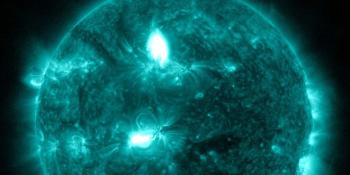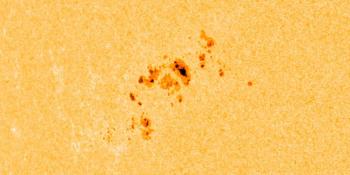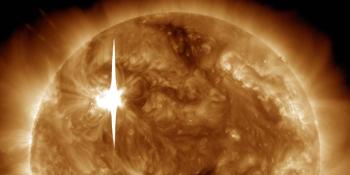Viendo archivo del lunes, 9 abril 2001
Informe actividad solar
Any mentioned solar flare in this report has a scaling factor applied by the Space Weather Prediction Center (SWPC). Because of the SWPC scaling factor, solar flares are reported as 42% smaller than for the science quality data. The scaling factor has been removed from our archived solar flare data to reflect the true physical units.
Informe de actividad Solar-Geofísica 2001 Apr 09 2200 UTCPreparado por NOAA © SWPC y procesado por SpaceWeatherLive.com
Informe conjunto USAF/NOAA de actividad Solar y Geofísica
SDF Número 099 Publicado el 2200Z a las 09 Apr 2001IA. Análisis de regiones solares activas y de actividad desde 08-2100Z hasta 09-2100Z Solar activity increased to high levels. Region 9415
(S22W07) produced an M7/2B flare at 09/1534 UTC associated with a
1600 SFU Tenflare, Type II and IV radio sweeps, and a full-halo CME.
Region 9415 remained a large, magnetically complex group with a
strong, persistent magnetic delta configuration within the large
leader spot. The remaining regions were simply-structured and showed
no significant changes. New Region 9425 (S25W26) was numbered.
IB. Pronóstico de la actividad solar
Solar activity is expected to be at
moderate to high levels. Region 9415 could produce another major
flare during the period.
IIA. Resumen de la actividad geofísica 08-2100Z a 09-2100Z
Geomagnetic field activity ranged from quiet to minor storm levels as
CME effects gradually subsided. The greater than 10 MeV proton flux
began to rise after today's major flare and was gradually increasing
as the period ended. A greater than 100 MeV proton flux enhancement
also followed the flare, but did not reach event levels.
IIB. Pronóstico de la actividad geofísica
Geomagnetic field activity is
expected to decrease to quiet to unsettled levels on 10 April. The
CME associated with today's flare is expected to reach Earth during
the early hours of 11 April. Active to major storm levels will be
possible during 11 - 12 April as the CME passes Earth. The greater
than 10 MeV proton flux may increase to event levels early on 10
April.
III. Probabilidades del evento 10 Apr a 12 Apr
| Clase M | 80% | 80% | 80% |
| Clase X | 25% | 25% | 25% |
| Protón | 70% | 25% | 25% |
| PCAF | yellow | ||
IV. Penticton 10.7cm flujo
Observado 09 Apr 165 Previsto 10 Apr-12 Apr 165/160/160 Media de 90 Días 09 Apr 167
V. Índices Geomagnéticos A
Observado Afr/Ap 08 Apr 033/041 Estimado Afr/Ap 09 Apr 018/025 Previsto Afr/Ap 10 Apr-12 Apr 012/015-030/035-025/025
VI. Probabilidades de Actividad Geomagnética 10 Apr a 12 Apr
| A. Latitudes Medias | |||
|---|---|---|---|
| Activo | 25% | 30% | 40% |
| Tormenta Menor | 10% | 30% | 20% |
| Tormenta Mayor-Severa | 05% | 25% | 05% |
| B. Latitudes Altas | |||
|---|---|---|---|
| Activo | 30% | 20% | 40% |
| Tormenta Menor | 15% | 35% | 15% |
| Tormenta Mayor-Severa | 05% | 20% | 10% |
< < Ir a la visión general diaria
Últimas noticias
Últimos mensajes del foro
Imagery from Total Solar Eclipse 08/04/2024 1Main page of website is down, black/blank circling loading circle for data. 8AR 3637, 3638, 3643 45Growth of Cycle 25 406Interesting four hour class 12
Más temasApoye a SpaceWeatherLive.com!
Mucha gente viene a SpaceWeatherLive para seguir la actividad del Sol o previsión de aurora, pero con esta cantidad de tráfico se incrementan los costos del servidor. ¡Considere hacer una donación si disfruta de SpaceWeatherLive para que podamos mantener el sitio web en línea!

Hechos clima espacial
| Último evento clase X | 2024/03/28 | X1.1 |
| Último evento clase M | 2024/04/18 | M1.5 |
| Últimas tormentas geomagnéticas | 2024/04/16 | Kp5 (G1) |
| Días sin manchas | |
|---|---|
| Último día sin manchas | 2022/06/08 |
| Promedio de manchas solares mensuales | |
|---|---|
| marzo 2024 | 104.9 -19.8 |


